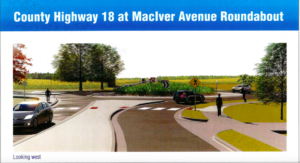The Wright County Highway Department announced Thursday, May 31 that the complete reconstruction of Wright County Highway 18, or 50th Street Northeast, will begin Monday, June 4, with multiple utility agencies on site to re-route services and road construction crews beginning to demolish the old thoroughfare.
The road will be closed from MacIver Avenue Northeast/Barthel Industrial Boulevard to Naber Avenue Northeast (Wright County Highway 22).
Detours and other information can be found on the Wright County website, which has a page dedicated to the project and detours. Drivers will be re-routed to Minnesota Highway 241, rather than through neighborhoods along Frankfort Parkway. Speed limits on Frankfort Parkway will be strictly enforced, the county said during open house conversations held last spring.
Veit & Company of Rogers, MN is the prime contractor that will be leading the construction, along with several sub-contractors the firm will be overseeing/supervising. Several private utility companies (M&P Nexlevel, Centerpoint, Centurylink, Charter, and Xcel Energy) will also be performing relocation work of their private utilities within the highway corridor in conjunction with the highway construction.
Although the highway will be detoured during construction, with a posted detour route, residents that live along the construction zone will have access to their homes. The construction is scheduled to continue into the Fall of 2018, when traffic will be opened to the public, with completion of the work coming in 2019.
St. Michael City Administrator Steve Bot said the current road doesn’t meet state aid standards and needs improvements to adequately service the 5,100 vehicles per day that drive on it.
“To my knowledge, it’s the most heavily traveled two-lane rural road in Wright County that just has a two-section roadway with no shoulders,” Bot said. “It definitely popped to their radar as needing some improvements, which, if you’ve driven down it, you probably agree.”
The project seeks to align Barthel Industrial Drive with MacIver Avenue, which currently meet up unevenly at CSAH 18, causing drivers to make a right turn off Barthel Industrial Drive followed by an immediate left turn onto MacIver Ave. to continue heading south. The proposed plan would create a single lane roundabout at that intersection, along with another roundabout at the current 4-way stop of CSAH 18 and Naber Ave., right by Middle School East.

In between the two roundabouts, the proposal calls for a widening of CSAH 18 from Barthel Industrial Drive to Naber Ave., with 12-foot drive lanes in either direction and a two-way left turn lane running down the center, as well as a couple right turn lanes for drivers heading into the Berningwood neighborhood on the south side of CSAH 18. There will be a 4-foot shoulder between the drive lanes and the curb, plus a 6-foot grassy boulevard between the road and the trail. The current proposal would move the trail from its location on the north side of the road to the south side of CSAH 18.

This project encompasses both St. Michael and Albertville portions of CSAH 18, and Wright County will also share in the funding of this project. The cost will be divided among the three entities based on Wright County’s cost participation policy. Assistant county engineer, Chad Hausmann, said firm cost estimates for the project will be available in the next month. Hausmann said they have also applied for some non-local funds that, if received, would help bring down the cost for all three entities.
What Can Drivers Expect During Construction?
Bot said that drivers can expect road closures to take place over the summer months so construction crews can work as fast as possible to ensure the road is ready for school traffic to Middle School East and Big Woods Elementary come September.
“We’re still looking at options to get done the fastest yet still provide reasonable access to the residents and the schools,” Hausmann said. “Originally we were thinking two phases but we know we can get it done a lot quicker with one, so if we have a good alternate route then we’ll consider doing it in one phase.”
Why Roundabouts Versus Traditional Intersections?
The public meeting information stressed the safety benefits of using roundabouts versus traditional intersections, citing research from the Minnesota Department of Transportation (MnDOT) that show significant crash reductions at intersections converted to roundabouts in Minnesota. MnDOT studied 144 intersections that converted to roundabouts and found they had 83 percent fewer serious injury crashes and an 86 percent reduction in fatal injury crashes after becoming roundabouts. The state said roundabouts virtually eliminate high-speed, right angle and head-on crashes, and have fewer conflict points than other types of intersections.